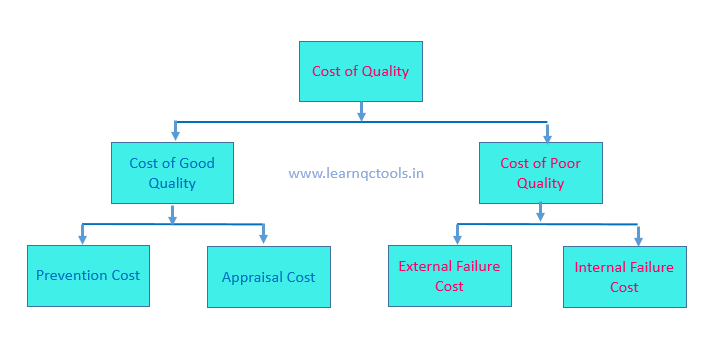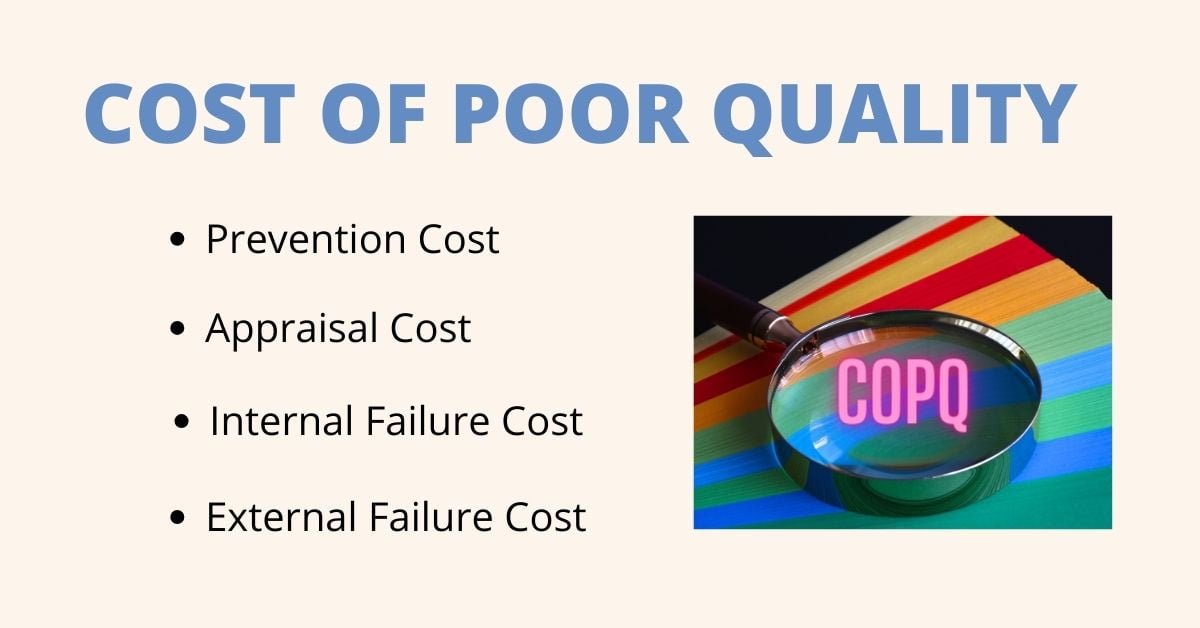Cost of Poor Quality:
The cost incurred in producing & rectifying a defect is called the cost of poor quality. It is also called the cost of non-conformance.
Purpose of COPQ:
- To reduce the cost by reducing the defect.
- To be aware of the money lost when a defect is produced in a product & detected at the in-house & customer end.
The cost of poor quality will be calculated for all rejections and rework at the in-house and customer ends. The MR/QA head will be responsible for calculating and reporting the Cost of Poor Quality.
Why Cost of Poor Quality?
If a company does not calculate COPQ, it may never know why it is incurring losses. It may also cut short inspection processes and skilled manpower, use cheap raw materials, and bypass processes to increase profit, which may ultimately lead to more quality problems.
Categories of cost of quality:

1. Prevention cost
2. Appraisal Cost
3. Internal Failure Cost
4. External Failure Cost
Cost of Good Quality:
In the Cost of Good Quality, there are included Prevention costs and Appraisal costs. It is also the cost for quality assurance.
Prevention Costs :
The cost incurred in preventing failures & reducing other costs to a minimum is called prevention costs.
- Activities of planning quality systems and translating product design & customer requirements into measures that will ensure product quality.
- The cost incurred in the product review.
- R&D testing
- Supplier assurance
- Cost includes developing & providing quality training.
- Quality system audit.
- Training employees on the quality standard
Appraisal Costs:
The cost incurred in the appraisal ( detection ) of product & process quality. It is a type of cost for quality control.
- All types of inspections. (Incoming, in process and Final inspection)
- Quality Audits and process audits.
- Calibration and maintenance of test equipment
- Laboratory testing
Cost of Poor Quality:
In cost of poor quality includes Internal failure cost and external failure cost. Here, internal failure means failure in-house in the company. External failure means failure at the customer end.
Internal Failure Costs:
Internal failure costs occur when the result of work is not as required & captured in-house.
- Scrap
- Rework and Repair
- In-house failure analysis
- Downtime of plant & machinery
- Rework and rejection of the supplier
- In-house analysis cost
External Failure Costs:
External failure cost occurs when output from an activity is not as per the requirement and captured at the customer end.
- Rework or replacement of the product
- Analysis & action taken for customer complaint
- Warranty claims
- Customer returns
- Product recall
The hidden cost of poor quality :
These are additional costs of quality that are hidden & do not appear on the COPQ calculation sheet. They are intangible and difficult to measure.
- Lost order/sale
- Loss of customers
- Management time loss
- Inventory increment
- Delivery problem
- Reputation damage
- Employee morale down
How to calculate COPQ?
The cost of poor quality will be calculated by capturing various internal and external failure costs. COPQ will normally be represented as % age of sales.
Cost of Poor Quality Formula:
Cost of poor quality percentage
COPQ% = (Total cost of Poor Quality/ Net sale of the month) x 100
where total cost includes internal failure costs and external failure costs.

This is a simple format for capturing the cost of poor quality. They included internal failure cost and external rejection cost. Internal rejection costs include rework costs and in-house rejection costs. External rejection costs include customer return costs, customer visit costs, segregation costs, analysis and debit costs etc.
Cost of Poor Quality Format | Cost of poor quality calculation Excel
Importance of COPQ in quality:
- COPQ reflects the total cost of defects, impacting profitability.
- Reducing COPQ improves overall financial performance and profit.
- High quality enhances reputation and gives a competitive edge.
- Minimizing COPQ leads to satisfied customers and loyalty.
- COPQ analysis identifies areas for process optimization.
- It helps identify and mitigate risks associated with poor quality.
- Monitoring COPQ is integral to ongoing quality enhancement.
- Managing COPQ ensures adherence to industry standards and regulations.
You may like to read about


Wow, amazing blog layout! How long have you been blogging for? you make blogging look easy. The overall look of your site is fantastic, as well as the content!